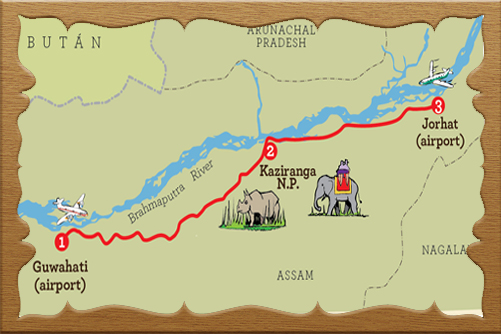Why in news?
As a fresh wave of floods ravages Assam, killing 73 and affecting nearly 40 lakh people across the state, 85 per cent of the Kaziranga National Park and Tiger Reserve (KNPTR) remains submerged.
What is the role of floods in Kaziranga’s ecosystem?
- Assam is traditionally flood prone, and the 1,055 sq km KNPTR — sandwiched between the Brahmaputra river and the Karbi Anglong Hills — is no exception.
- It is a riverine ecosystem, not a solid landmass-based ecosystem. The system won’t survive without water. The entire area of Kaziranga — formed by alluvial deposits from the Brahmaputra and its tributaries — is centred around the river.
- This “floodplain eco system” has not only been created by floods but also feeds off it.
- The regenerative nature of floods helps replenish Kaziranga’s water bodies and maintain its landscape, a mix of wetlands, grasslands and semi-evergreen deciduous forests.
- Floodwaters also function as a breeding ground for fish. The same fish are carried away by the receding waters into the Brahmaputra — in a way, the park replenishes the river’s stock of fish too.
- The waters also help get rid of unwanted plants such as water hyacinth which collect in huge masses in the landscape.
- In a herbivore-dominated area like Kaziranga, it is important we maintain its grassland status. If it were not for the annual floods, the area would become a woodland.
- Many also believe that floods are a way of natural selection. A number of animals — especially the old, weak — cannot survive the floods. Only the ones with superior genes survive.


Can the floods become problematic for Kaziranga?
- Barring 2018, the years between 2016 and 2020 have all featured high floods (or floods which submerge more than 60 per cent of the park) killing and injuring hundreds of animals.
- Animals adapt naturally to floods but when the waters hit a certain level, they gravitate towards safer, higher ground in the Karbi Anglong hills.
- While in the past, Kaziranga and Karbi Anglong were part of the same landscape, the animals now have to cross the bustling National Highway 37 which cuts across the park.
- Mushrooming of hotels, restaurants, shops, and ancillary structures of the tea industry has not helped either.
- As a result, animals that venture out of the park, die either under the wheels of speeding vehicles on the highway, or are killed by poachers who take advantage of their vulnerability.
What measures are taken to prepare for the flood?
- Preparedness begins a month before floods hit. The authorities keep a track of updates from the Central Water Commission, and monitor water levels of the Brahmaputra tributaries upstream in Arunachal Pradesh.
- To avoid disease outbreaks, a door-to-door vaccination is organised every year pre-floods. “Thereafter, camps are organised to create awareness against poaching and harming wild animals that are rendered vulnerable during the floods.”
- Moreover, when the floods hit, Section 144 is imposed along NH-37, speed limits are enforced and fines levied.
- Barricades are also placed to help animals cross over to Karbi Anglong.
- The efforts of the forest department’s frontline staff become crucial during the season.
How helpful are Kaziranga’s artificial highlands?
- Over the years, another mitigation measure has been artificial highlands (111 in the Nineties, 33 in 2016-17) built inside the park for wild animals to take refuge in during the flood.
- While these highlands have helped a fair bit in reducing the number of animal casualties during floods, some feel that it is not a ‘permanent solution’.
- Animals do take refuge there — especially rhino and swamp deer — but it is not viable to build more highlands since such constructions will ruin the natural ecosystem.
- These 33 highlands cannot accommodate all animals of Kaziranga, and the older ones are more or less dilapidated.
- Some animals do not take to the highlands naturally.
- They have been migrating to natural highlands of Karbi Anglong for centuries; suddenly these artificial constructions do not inspire confidence, they do not find it secure.
Background:
Kaziranga National Park
It is located in Golaghat and Nagaon, in the Karbi Anglong district of Assam in northeast India.

About the Park:
- In the year 1985, the park was declared as a World Heritage Site by UNESCO.
- Along with the iconic Greater one-horned rhinoceros, the park is the breeding ground of elephants, wild water buffalo, and swamp deer.
- Over the time, the tiger population has also increased in Kaziranga, and that’s the reason why Kaziranga was declared as Tiger Reserve in 2006.
- Also, the park is recognized as an Important Bird Area by BirdLife International for the conservation of avifaunal species. Birds like lesser white-fronted goose, ferruginous duck, Baer’s pochard duck and lesser adjutant, greater adjutant, black-necked stork, and Asian Openbill stork specially migrate from the Central Asia during the winter season.
- The park has successfully managed to grow the population of Greater one-horned rhinoceros, an endangered species.
- The vast expanse of tall elephant grass, marshland, and dense tropical moist broadleaf forests undoubtedly makes the park look beautiful but it’s the presence of Brahmaputra river, which makes it look enigmatic.
- Due to the difference in altitude between the eastern and western areas of the park, here one can see mainly four types of vegetation’ like alluvial inundated grasslands, alluvial savanna woodlands, tropical moist mixed deciduous forests, and tropical semi-evergreen forests.
About Asian One-horned Rhinoceros
- The Indian Rhinoceros (Rhinoceros unicornis) is also called Greater One-horned Rhinoceros and Asian One-horned Rhinoceros and belongs to the Rhinocerotidae family.
- It is listed as Vulnerable on the IUCN Red List.
- Primarily found in parts of north-eastern India and in protected areas in the Terai of Nepal, where populations are confined to the riverine grasslands in the foothills of the Himalayas.
- Weighing between 2260 kg and 3000 kg, it is the fourth largest land animal and has a single horn.
- These Rhinoceros once ranged throughout the entire stretch of the Indo-Gangetic Plain but excessive hunting reduced their natural habitat drastically. Today, about 3,000 Rhinos live in the wild, 2000 of which are found in Assam’s Kaziranga alone.
- It has excellent senses of hearing and smell but relatively poor eyesight.
Thank you!





